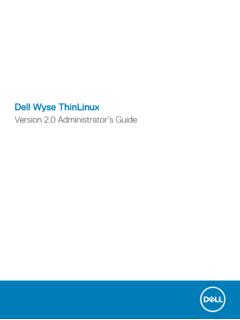Transcription of XPS 13 - topics-cdn.dell.com
1 XPS 13. Service Manual Regulatory Model: P82G. Regulatory Type: P82G001. Notes, cautions, and warnings NOTE: A NOTE indicates important information that helps you make better use of your product. CAUTION: A CAUTION indicates either potential damage to hardware or loss of data and tells you how to avoid the problem. WARNING: A WARNING indicates a potential for property damage, personal injury, or death. 2018 - 2019 Dell Inc. or its subsidiaries. All rights reserved. Dell, EMC, and other trademarks are trademarks of Dell Inc. or its subsidiaries. Other trademarks may be trademarks of their respective owners. 2019 - 02. Rev. A05. Contents 1 Before working inside your 7. Before you begin ..7. Safety recommended Screw 8. 2 After working inside your 9. 3 Removing the base 4 Replacing the base 13. 5 Removing the Lithium-ion battery 14.
2 14. 6 Replacing the Lithium-ion battery 16. 7 Removing the solid-state 17. 17. 17. 8 Replacing the solid-state 9 Removing the 19. 19. 10 Replacing the 20. 11 Removing the coin-cell 21. Contents 3. 12 Replacing the coin-cell 22. 22. 22. 13 Removing the heat 23. 23. 14 Replacing the heat 24. 24. 15 Removing the display 25. 25. 25. 16 Replacing the display 27. 27. 27. 17 Removing the headset 28. 28. 18 Replacing the headset 30. 30. 19 Removing the 31. 20 Replacing the 33. 33. 33. 21 Removing the system 34. 34. 22 Replacing the system 36. Entering the Service Tag in the BIOS setup 36. 23 Removing the power button with optional fingerprint 37. 4 Contents 37. 24 Replacing the power button with optional fingerprint 38. 38. 25 Removing the 39. 39. 26 Replacing the 40. 27 Removing the palm-rest 41. 41. 28 Replacing the palm-rest 42.
3 42. 29 Downloading 43. Downloading the audio Downloading the graphics 43. Downloading the USB 44. Downloading the Wi-Fi Downloading the media-card reader Downloading the fingerprint reader 45. Downloading the chipset 46. Downloading the network 46. 30 System 48. System 48. Entering BIOS setup Enabling or disabling the USB in BIOS setup Identifying the storage drive in BIOS setup Checking the system memory in BIOS setup Navigation Boot 49. System setup 49. System and setup Assigning a system setup 54. Deleting or changing an existing system setup Clearing CMOS 55. Clearing BIOS (System Setup) and System 31 Enhanced Pre-Boot System Assessment (ePSA) Contents 5. Running the ePSA System diagnostic Flashing the 57. Flashing BIOS (USB key)..57. Fixing a no-boot issue caused by USB-boot 58. Flea power Wi-Fi power 32 Getting help and contacting 59.
4 6 Contents 1. Before working inside your computer NOTE: The images in this document may differ from your computer depending on the configuration you ordered. Before you begin 1. Save and close all open files and exit all open applications. 2. Shut down your computer. Click Start > Power > Shut down. NOTE: If you are using a different operating system, see the documentation of your operating system for shut-down instructions. 3. Disconnect your computer and all attached devices from their electrical outlets. 4. Disconnect all attached network devices and peripherals, such as keyboard, mouse, and monitor from your computer. 5. Remove any media card and optical disc from your computer, if applicable. Safety instructions Use the following safety guidelines to protect your computer from potential damage and ensure your personal safety.
5 NOTE: Before working inside your computer, read the safety information that shipped with your computer. For more safety best practices, see the Regulatory Compliance home page at NOTE: Disconnect all power sources before opening the computer cover or panels. After you finish working inside the computer, replace all covers, panels, and screws before connecting to the electrical outlet. CAUTION: To avoid damaging the computer, ensure that the work surface is flat and clean. CAUTION: To avoid damaging the components and cards, handle them by their edges, and avoid touching pins and contacts. CAUTION: You should only perform troubleshooting and repairs as authorized or directed by the Dell technical assistance team. Damage due to servicing that is not authorized by Dell is not covered by your warranty. See the safety instructions that shipped with the product or at CAUTION: Before touching anything inside your computer, ground yourself by touching an unpainted metal surface, such as the metal at the back of the computer.
6 While you work, periodically touch an unpainted metal surface to dissipate static electricity, which could harm internal components. CAUTION: When you disconnect a cable, pull on its connector or on its pull tab, not on the cable itself. Some cables have connectors with locking tabs or thumb-screws that you must disengage before disconnecting the cable. When disconnecting cables, keep them evenly aligned to avoid bending any connector pins. When connecting cables, ensure that the ports and connectors are correctly oriented and aligned. CAUTION: Press and eject any installed card from the media-card reader. recommended tools The procedures in this document may require the following tools: Phillips #00 and #01 screwdriver Torx #5 (T5) screwdriver Plastic scribe Before working inside your computer 7. Screw list The following table provides the list of screws that are used for securing different components.
7 NOTE: When removing screws from a component, it is recommended to note the screw type, the quantity of screws and then place them in a screw storage box. This is to ensure that the correct number of screws and correct screw type is restored when the component is replaced. NOTE: Some computers have magnetic surfaces. Ensure that the screws are not left attached to such magnetic surfaces when replacing a component. Table 1. Screw list Component Secured to Screw type Quantity Screw image Keyboard Palm-rest assembly 29. Fingerprint-reader board Palm-rest assembly 1. NOTE: This component is only available on systems with fingerprint reader integrated on the power button. Power button Palm-rest assembly 2. System board Palm-rest assembly 10. Fans System board 2. Speakers Palm-rest assembly M2x2 4. Heat sink System board M2x3 4.
8 Headset port Palm-rest assembly 4. Display assembly Palm-rest assembly 4. Wireless antenna and System board 1. camera cable bracket Display cable bracket System board 2. Solid-state drive shield System board M2x3L 1. and solid-state drive Battery Palm-rest assembly M2x2 4. Battery Palm-rest assembly 1. Base cover Palm-rest assembly M2x3, Torx 8. 8 Before working inside your computer 2. After working inside your computer CAUTION: Leaving stray or loose screws inside your computer may severely damage your computer. 1. Replace all screws and ensure that no stray screws remain inside your computer. 2. Connect any external devices, peripherals, or cables you removed before working on your computer. 3. Replace any media cards, discs, or any other parts that you removed before working on your computer. 4. Connect your computer and all attached devices to their electrical outlets.
9 5. Turn on your computer. After working inside your computer 9. 3. Removing the base cover NOTE: Before working inside your computer, read the safety information that shipped with your computer and follow the steps in Before working inside your computer. After working inside your computer, follow the instructions in After working inside your computer. For more safety best practices, see the Regulatory Compliance home page at Procedure 1. Remove the eight screws (M2x3, Torx) that secure the base cover to the palm-rest assembly. 2. With the computer face-down, open the computer at an angle. 3. Using a plastic scribe, pry the base cover from the palm-rest assembly. 10 Removing the base cover 4. Moving the base cover from left to right, release the clips securing the base cover to the palm-rest assembly. 5. Lift the base cover from the palm-rest assembly.
10 6. Disconnect the battery cable from the system board. Removing the base cover 11. 12 Removing the base cover 4. Replacing the base cover NOTE: Before working inside your computer, read the safety information that shipped with your computer and follow the steps in Before working inside your computer. After working inside your computer, follow the instructions in After working inside your computer. For more safety best practices, see the Regulatory Compliance home page at Procedure 1. Connect the battery cable to the system board. 2. Align the screw holes on the base cover with the screw holes on the palm-rest assembly and snap the base cover into place. 3. Replace the eight screws (M2x3, Torx) that secure the base cover to the palm-rest assembly. Replacing the base cover 13. 5. Removing the battery NOTE: Before working inside your computer, read the safety information that shipped with your computer and follow the steps in Before working inside your computer.









